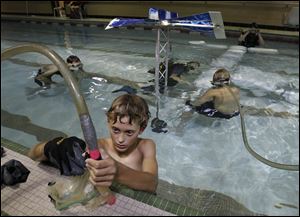
Campers take off for outer space
Participants go under water to build station
7/23/2012
Austin Stoner, 12, hooks up his surface-supplied air snorkel before helping the rest of his Challenger Learning Center camp team assemble a model of the International Space Station.
Amidst a crowd of spectators, seven team members carefully constructed an international space station in Toledo on Friday afternoon.
The location was an indoor pool on Collingwood Boulevard, and the team members were seven local youths participating in the International Space Station Camp, one of eight summer programs offered by the Challenger Learning Center in Oregon.
The week-long camp taught the children the purpose and history of the International Space Station, as well as how to snorkel. The camp culminated in building a 22-foot-by-50-foot-by-12-foot model of the space station underwater.
"We do this [underwater] because this is the way astronauts train," program coordinator Reed Steele said. "It gives us that feeling of floating in space."
The space station camp is offered annually to area youth who are entering seventh grade or above.
J.T. Langdon, who will be a seventh grader at Toledo School for the Arts, said he has been attending Challenger camps since he was in third grade.
"This is the first year I could be in this one, and I was looking forward to it," J.T. said. "It's fun, and I get to learn stuff over the summer."
Pam Langdon, J.T.'s mother, said she appreciates her son's passion for Challenger camps as well.
"I love that there's so much hands-on activity, and it really gets the science to come to life," Ms. Langdon of Toledo said.
The group built the space station in three rotations so each participant experienced every position. The roles included mission specialists who put the structure together underwater, life support officers who held breathing tubes for those underwater, and public relations officers who described what was happening.
During his time as the public relations officer, Wisler Coulter, a 12-year-old from Toledo, said he particularly enjoyed acting as mission specialist.
"Then I get to go underwater and put all the pieces together," Wisler said.
Wisler, a first-time camp attendee, said his favorite portion was learning how to snorkel.
Mr. Steele, who played the role of simulation supervisor, said all the participants were eagerly anticipating the camp's final project.
"They're very concerned, like 'I want to make sure my part is right,' like astronauts when they go up there, they think 'I don't want to screw up this mission,' because it also affects everybody else," Mr. Steele said.
The Challenger Learning Camps give local students opportunities to pursue science education fields which might not be covered in the classroom, Mr. Steele said. Each camp focuses on different grade levels and tailors the experience in order to best capture the children's interest.
"It also has a tendency to help students during the school year," he said. "If you go to school then aren't doing anything for the summertime you have a tendency to forget a lot of things, but if your mind is sharp during the summer you have a tendency to pick things up quicker during the school year."
Ketlove Coulter, Wisler's sister and a student at Washington Junior High, said the camp made learning fun.
"We had a competition of who can do the most tricks and stuff underwater with our snorkels on," Ketlove, 13, said. "I'll probably do the camp again."
Contact Mel Flanagan at: mflanagan@theblade.com or 419-724-6087.